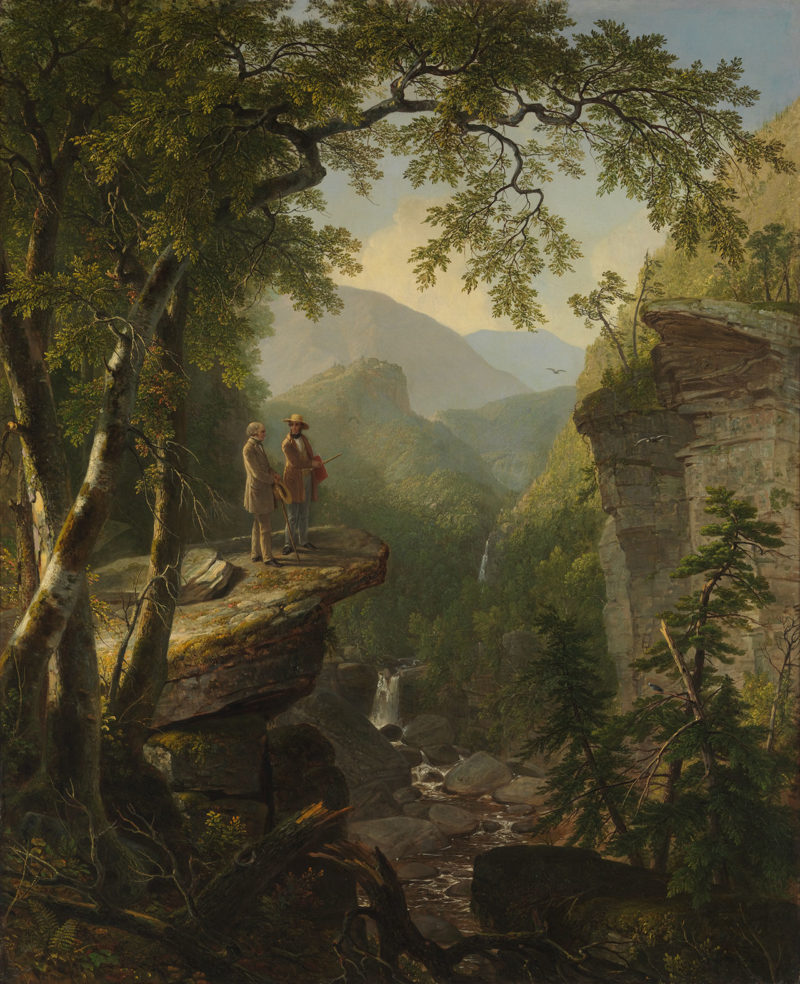Essay
With roots in European Romanticism and with correspondences to European painters such as the Nazarenes and Caspar David Friedrich in Germany, or John Constable and Joseph Turner in England, the Hudson River painters nonetheless set about heeding Emerson’s call “to ignore the courtly Muses of Europe” and define a distinct vision for American art. They were artists who came to maturity in the years of egalitarian Jacksonian democracy and expansion; they translated these ideals into an aesthetic that was sweeping and spontaneous. The Hudson River painters celebrated the vast nation that lay before them not chauvinistically but with a sense of awe for its majestic natural resources, and a feeling of optimism for its huge potential. They depicted a New World wilderness in which man, minuscule as he was beside the vastness of creation, nevertheless retained that divine spark that completed the circle of harmony.
As Thomas Cole maintained, if nature stayed untouched by the hand of man–which much of the primeval American landscape in the early 19th century was–then man could become more easily acquainted with the hand of God. The Hudson River painters created visual embodiments of the ideals of American Transcendentalist writers like Emerson, Thoreau, William Cullen Bryant, and Walt Whitman. Concurring with Emerson, who had written in his 1841 essay “Thoughts on Art” that painting should become a vehicle through which the universal mind could reach the mind of mankind, the Hudson River painters believed art to be an agent of moral and spiritual transformation.
The impetus to celebrate the glories of the Hudson Valley began before Thomas Cole with painters such as Thomas Doughty, Thomas Chambers, and Jasper Francis Cropsey, but it was Cole, with his literary and dramatic instincts and his years of European study who made the most coherent and articulated case for a new art for a new land. With Asher B. Durand, he did much to revolutionize not only the styles and themes of American painting, but the methods as well. Cole sketched from nature–frequently dramatic vistas in the Catskills or White Mountains–and then returned to his studio to compose his large scale canvasses, alive with tactile brushwork and atmospheric lighting that seemed to breathe.
Luminists & Late Romantics
The influence of the Hudson River School was carried into the mid-19th century by artists like John Frederick Kensett and Martin Johnson Heade, who came to be known as Luminists because of their experiments with the effects of light on water and sky, and by Frederic Edwin Church. Church based himself in his Persian-style home named Olana, with its panoramic view of the Hudson River and the Catskills, but he sought more extensive horizons for his canvasses. Like Walt Whitman, he tried to contain multitudes. He traveled the globe, painting scenery from the Hudson Valley to the American West to the Andes, the Amazon, and the Arctic, and he laid the foundation for the post-Civil War generation of landscape painters, among them Albert Bierstadt and George Inness.
A painting which has become a virtual emblem for the Hudson River School is the dramatic 46″ x 36″ canvas by Asher B. Durand called Kindred Spirits. Durand depicts himself, together with Cole, on a rocky promontory in serene contemplation of the scene before them: the gorge with its running stream, the gossamer Catskill mists shimmering in a palette of subtle colors, framed by foliage. In the foreground stands one of the Hudson River School’s famous symbols, in this case a broken tree stump, which Cole called a “memento mori”–a reminder that life is fragile and impermanent; only Nature and the Divine within the Human Soul are eternal. Tiny as the human beings are in this composition, they are nevertheless elevated by the grandeur of the landscape with which they are in harmony. As Cole and Durand firmly believed, if the American landscape was a new Garden of Eden, then it was they, as artists, who kept the keys of entry.
–Thomas Hampson and Carla Maria Verdino-Süllwold, PBS I Hear America Singing
Image: “Kindred Spirits” by Asher Brown Durant (1849)
Asher Brown Durand's "Kindred Spirits" (1849)


